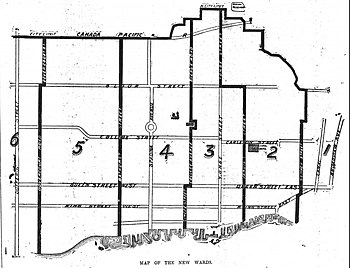This article needs additional citations for verification. (September 2020) |
Municipal elections were held in Toronto, Ontario, Canada, on January 1, 1909. Joseph Oliver was easily re-elected to his second term as Mayor of Toronto. One of the central issues of the campaign was whether the city should construct a bridge over the Don River connecting Bloor Street to Danforth Avenue. A referendum was held as part of the vote, and the bridge was approved. It would be built as the Prince Edward Viaduct.
Toronto mayor
Oliver had been elected in the 1908 election, and was easily reelected while facing no serious opposition.
- Results
- Joseph Oliver (incumbent) - 27,128
- Thomas Davies - 8,127
- James Lindala - 1,735
- Joel Marvin Briggs - 327
Board of Control
The election was accompanied by a referendum on reducing the number of licensed bars in the city by 40. The measure passed, but in a surprise upset Controller Frank S. Spence, who was the strongest advocate for the measure, was defeated. His place on the Toronto Board of Control was taken by former Alderman George Reginald Geary who had been defeated by Oliver for Mayor the year previously. Alderman James Hales also tried to gain a seat on the board.
- George Reginald Geary - 20,136
- Horatio Clarence Hocken (incumbent) - 17,630
- J.J. Ward (incumbent) - 15,782
- William Spence Harrison (incumbent) - 14,037
- Frank S. Spence (incumbent) - 13,296
- William Peyton Hubbard - 11,391
- James Hales - 8,462
- Robert Buist Noble - 1,393
- James O'Hara - 808
City council

Three aldermen were elected to Toronto City Council per ward.
- Ward 1 (Riverdale)
- Daniel Chisholm (incumbent) - 2,104
- Zephaniah Hilton - 1,836
- Andrew McMillan - 1,824
- Thomas N. Phelan - 1,748
- William Temple Stewart (incumbent) - 1,392
- William J. Saunderson (incumbent) - 1,246
- Robert Fleming - 1,039
- John Macpherson Ross - 912
- William Totten - 488
- William Worrell - 472
- John Linden - 213
- Ward 2 (Cabbagetown and Rosedale)
- Tommy Church (incumbent) - 2,776
- John O'Neill - 2,496
- Thomas Foster (incumbent) - 1,981
- John Noble - 1,421
- Robert Yeomans - 1,241
- William Norton Eastwood - 916
- Ewart Farquahar - 517
- William Alexander Douglas - 502
- Frederick Hogg - 359
- Richard Wallace - 328
- Ward 3 (Central Business District and The Ward)
- Mark Bredin (incumbent) - 2,989
- John Wilson Bengough (incumbent) - 2,630
- Charles A. Maguire - 2,488
- Sam McBride (incumbent) - 2,391
- Oliver B. Sheppard - 2,309
- Stewart Nassau Hughes - 1,323
- Louis Gurofsky - 660
- John Kirk - 519
- Thomas Egan - 509
- Paul Levi - 298
- Ward 4 (Kensington Market and Garment District)
- George McMurrich (incumbent) - 3,599
- R.C. Vaughan (incumbent) - 2,173
- Albert Welch - 2,974
- James Brandon - 2,735
- Thomas Alexander Lytle (incumbent) - 2,248
- Ward 5 (Trinity-Bellwoods)
- Robert Henry Graham (incumbent) - 3,191
- John Dunn - 2,933
- Albert James Keeler (incumbent) - 2,946
- Peter Whytock (incumbent) - 2,626
- Joseph May - 2,213
- John L. Richardson - 1,357
- Robert William Dockeray - 1,792
- Thomas Gillies - 519
- Frederick Jenkins - 509
- Ward 6 (Brockton and Parkdale)
- James Henry McGhie (incumbent) - 3,453
- John James Graham (incumbent) - 3,043
- J.H. Adams (incumbent) - 2,456
- Fred McBrien - 2,444
- James Arthur McCausland - 2,273
- William Hodgson - 754
- Thomas Mathison - 578
Creation of Ward 7

The City of West Toronto was annexed on May 1, 1909 and became Ward 7. Due to its smaller size it had only two aldermen. A by-election was held on May 29, 1909.
- Ward 7
- A.J. Anderson - 777
- William Alexander Baird - 603
- Samuel Ryding - 363
- Jesse C. Smith - 337
- Joseph S. Bull - 282
References
Results taken from the January 2, 1909 Toronto Globe and might not exactly match final tallies.








